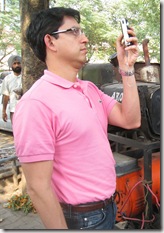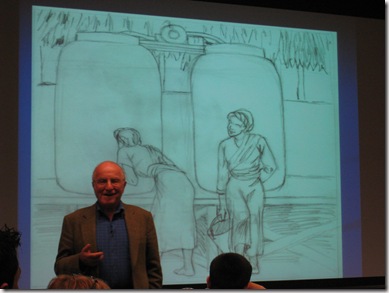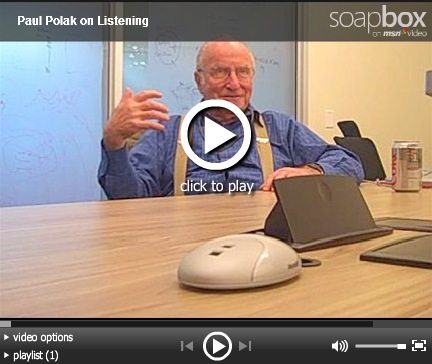Paul Polak and the Art of Listening
Paul Polak is a hero of mine.
He created a nonprofit organization called International Development Enterprises (IDE) and spent 25 years there developing creative ways to make poor people in Asia and Africa less poor. His specialty is developing sustainable tools that rural farmers earning $2/day actually buy in order to increase the amount of cash they generate; his approach is to spend an intensive amount of time in the field listening to these types of farmers in order to truly understand what they need; and his results have been amazing. His organization developed and marketed something called a treadle pump, a low cost human-powered $25 pump that made it easier for subsistence farmers to grow lucrative off-season vegetables by simply tapping into the water table that lay 15 feet beneath their feet. IDE has sold over 2 million of these pumps to some of the poorest people in the world, and almost all of them achieved a payback on their investment in a matter months, lifting their families from $2/day to $5/day in the process. What’s cool about Paul’s approach is that he didn’t just invent a pump, he created a complete ecosystem of local manufacturers, distributers, and marketers that figured out everything they needed to do in order to connect with local people and sell a product on local terms that could transform the lives of poor people. IDE is now a 500 person organization chugging along on its mission of helping the rural poor.
Paul’s Book, Out of Poverty, is required reading for anyone working in the International Development or ICT4D spaces because it lays out a fact-based model for managing projects that achieve their desired impact. Heck, it should be required reading for anyone in business because, well, it lays out a fact-based model for managing projects that achieve their desired impact.
Paul visited the Microsoft campus on Monday and gave a talk about his work. So what does a 75 year-old ex-psychologist, businessman, NGO-founder, and author do as a next step in his life? Why, start two new companies, of course! One of them is the design firm D-Rev that helps multinationals in designing products for poor people. The other is a firm that is developing its own products to take to market. The photo above shows Paul describing the concept behind one of his new company’s products in the speech he gave on Monday.
During his talk, he described his “Don’t Bother Trilogy” of rules that you absolutely need to do in creating a business case for a product targeting people living at the bottom of the pyramid. He calls them this particular name because if you don’t do them, then don’t bother proposing the project to him.
- Go out and talk to at least 25 poor people in your target market, and spend at least four hours with each of them in order to truly understand what they need
- Create a pricing and costing model where the poor people buying your product can achieve a positive return on their investment within three months of purchase
- Select an idea with an addressable market of at least one million units
Clearly, the most important tool in his toolbox, the one he places the most value in, is the art of listening. Paul estimates that during his time at IDE he conducted 3,000 of these 4 hour interviews with farmers and their families in their homes and in their fields throughout the world. He actually videotaped most of these interviews and still has the tapes if any aspiring documentary film makers out there are looking for a new and interesting project.
After his speech on Monday, I had the chance to sit down with Paul and among other things discuss with him the art of listening within the context of developing new products. Here is a quick video where he describes how he went into the hills of Vietnam looking to sell drip irrigation systems but wound up getting into the pig business.
From his perspective, it comes down to making a human connection in a fact-based conversation that focuses on the outcomes that matter. For $2/day consumers, that outcome is increasing income.
 So what does all of this have to do with Microsoft? Well here in the Unlimited Potential Group, we are trying to build technology products that target the specific needs of consumers in emerging market countries. We have to put ourselves in the shoes of the people we are trying to reach, and I have to tell you it is a really hard thing to do, especially from Redmond. Sure we have local employees and local partners who help us understand emerging market requirements, our research and user experience teams do various types of behavioral and ethnographic studies, and our product managers spend a lot of time on the road interviewing people and evaluating our various technology incubation trials (while taking lots of pictures and videos in the process.) Shown here is my colleague Alberto Martinez, who was with me in India 10 days ago when we were doing some consumer research there.
So what does all of this have to do with Microsoft? Well here in the Unlimited Potential Group, we are trying to build technology products that target the specific needs of consumers in emerging market countries. We have to put ourselves in the shoes of the people we are trying to reach, and I have to tell you it is a really hard thing to do, especially from Redmond. Sure we have local employees and local partners who help us understand emerging market requirements, our research and user experience teams do various types of behavioral and ethnographic studies, and our product managers spend a lot of time on the road interviewing people and evaluating our various technology incubation trials (while taking lots of pictures and videos in the process.) Shown here is my colleague Alberto Martinez, who was with me in India 10 days ago when we were doing some consumer research there.
But it’s hard enough to get customer requirements right for products being launched in the US; getting them right from the US for products designed for customers in India and China adds a degree a difficulty that reminds me of the line from Ginger Rogers, where she said she had to do the same dancing Fred Astaire did, except she had to do it backwards while wearing high heels.
So it can be done, and Paul is helping us, oftentimes in ways that we didn’t initially expect. No, he is not teaching us how to dance backwards, but last summer he was a judge in the Imagine Cup Rural Innovation Awards and participated on the panel that gave the first prize to the kids from Indonesia and their Project Butterfly submission. After the contest, he gave us feedback that he didn’t see enough evidence of students actually listening to their target customers in the process of designing their submissions, so for this year’s UP award at Imagine Cup we are making a formal requirement that the submissions adopt Guidelines for User Centric Design and document the number and types of conversations they’ve had with their target customers.
(By the way, the entire 2009 Imagine Cup is organized around the UN Millennium Development Goals, which means 200,000+ college students around the world will be applying their energy and creativity in a competition addressing the world’s most important social and economic problems! It is an amazing idea and will occupy a big chunk of my 2009.)
Anyway, for marketers and product developers, doing a good job at the art of listening can make the difference between writing an interesting trip report and delivering a product that achieves real impact with measurable outcomes in a completely different part of the world. And this week many of us here at Microsoft had the chance to meet face-to-face with someone who demonstrates on a consistent basis that it can be done. So it was a really good week.
And Paul, I listened. :-)

